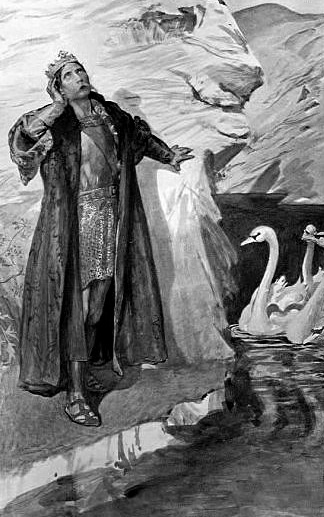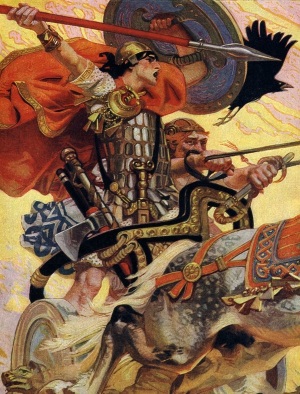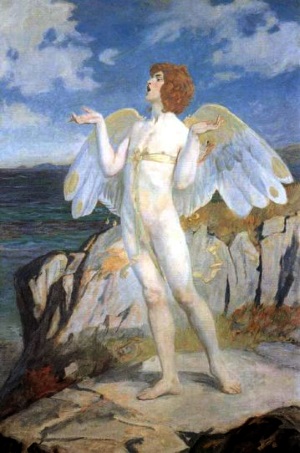The Swan In Celtic Mythology

The Swan, which is called "Eala" in Scots Gaelic, "Eala" in Irish, "Alarch" in Welsh, "Alarc’h" in Breton, "Olla" in Manx and "Alargh" Cornish, is known for its majestic grace and gliding mystical beauty. Little wonder then that these birds of the family Anatidae within the genus Cygnus are associated with the gods and goddesses of the pre-Christian Celtic peoples. They are seen as having links to the Otherworld (Aos Si) community whose world was reached through mists, hills, lakes, ponds, wetland areas, caves, ancient burial sites, cairns and mounds. Within these realms dwelt the Celtic gods with all of their supernatural ability. Association with these deities gave the swan an exalted status linked to the Celtic festivals such as those of Beltane and Samhain.
Swan species are: Whooper, Trumpeter, Tundra, Mute, Black-necked, Black, and Berwick. A male swan is called a cob; a female is a pen, and the young are called cygnets. The Northern Hemisphere species of swan have a plumage of pure white. The Southern Hemisphere species are mixed black and white. The Australian black swan is black except for the white flight feathers on its wings. However, the white Mute Swan was also introduced to Australia and New Zealand. The South American black-necked swan has a white body with a black neck. Largest of the waterfowl family Anatidae, the swan is one of the biggest of the flying birds. The larger of the species, including the mute swan, trumpeter swan, and whooper swan, can be over 59 in (1.5 m) with a weight of over 33 Ib (15 kg). Wingspans can extend to over 10 ft (3.1 m). Swans are noted as usually choosing a mate that lasts for life.
Throughout the Celtic nations there are myths and legends featuring Swans. They appear throughout Irish folklore. One such legend being the ‘Children of Lir’. This Irish Legend tells of the Clann Lir and the story is recounted in one of the cycles of Irish mythology. The Mythological Cycle looks at the the pre-Christian Celtic gods of Tuatha Dé Danann a magical race of people said to have come to Ireland from four Cities in the north. Lebor Gabála Érenn (The Book of Invasions) compiled in the 11th Century tells how they arrived in 'dark clouds'. These people were attributed with supernatural powers and Lir was a Sea God and father of the legendary Manannán mac Lir.
Lir was also said to be the father of a daughter Fionnula and three sons Aed, Fiachra and Conn. The statue in Dublin’s Garden of Remembrance is based on the legend of these four 'Children of Lir'. Lir's wife and mother of his four children, Aiobh, died. Lir then married her sister Aiofe. In time she grew jealous of the children’s love for Lir and their mother and cast a spell upon them which changed them into swans. The spell was to last 900 years, 300 years on Lough Derravaragh, 300 on the Sea of Moyle and 300 on Irrus Domnann near Inishglora. It would only be lifted when they heard the bell of the new God. Lir when he learnt of Aiofe’s act banished her to become a demon of the air.
After 900 years, when the time of the Tuatha Dé Danann had passed and aided by a monk, Mochua, the children heard the sound of a church bell. The spell was lifted and the children turned back into human form but aged rapidly and died.

The swan also appears in the tale of Cú Chulainn, who is an Irish mythological hero who appears in the stories of the Ulster Cycle, as well as in Scottish and Manx folklore.
In the tale of the Scandinavian Princess Derbforgaill who fell in love with Cú Chulainn, she transformed herself and her maidens into swans to travel and be near him. Not realising who it was Cú Chulainn, threw a stone at one of the swans, causing the bird to fall to the ground. She transformed back into human form and it was Derbforgaill. As she lay injured and bleeding at his feet Cú Chulainn then saved her life by taking the stone from her side and sucking out some of her blood. Although he had saved her, by sucking some of her blood, it had made it impossible for him to marry her. Derbforgaill subsequently married his foster-son Lugaid Riab nDerg.
Another story from Irish legend involves Aengus. He was the son of the the Dagda and Boann. The Dagda was a powerful God of the Tuatha Dé Danann who are a significant feature in Irish, Scottish and Manx mythology. Boann was the Irish goddess of the River Boyne, that flows through Leinster, Ireland. Aengus was said to have lived at Newgrange by the River Boyne

In The Dream of Aengus, the young god saw a woman in his dreams whose name was Caer Ibormeith the Celtic goddess of sleep and dreams. He fell in love with her. Aengus set out to find Caer and discovered that she was more than a dream, but a real person who had been placed under a spell. She and her sisters are transformed into swans every second Samhain and remain in that form until the following Samhain. The Celtic pagan festival of Samhain is one of the four Gaelic seasonal festivals, along with Imbolc, Beltane and Lughnasadh and was celebrated throughout Ireland, Scotland and the Isle of Man. It falls on 31 October and is the basis for Halloween. It is a time of year celebrated in other Celtic lands; Calan Gaeaf (in Wales), Kalan Gwav (in Cornwall), and Kalan Goañv (in Brittany).
In the story of Aengus and Caer he found her at a Lough known as the Loch of The Dragons Mouth, now thought to be Lough Muskry in the Galtee Mountains or Galty Mountains (Irish: Na Gaibhlte or Sléibhte na gCoillte) where the transformation took place. When Aengus arrived, there were 150 swans and he had to choose Caer from amongst them. He chose correctly, then turned into a swan himself. It is said that they flew away together, to the fortress of Brugh na Boinne singing beautiful music that put all of its listeners asleep for three days and nights.
So long may the swan reign in all its majesty and beauty. In Celtic hearts this magnificent bird holds a special place. Along with all wildlife on our increasingly overcrowded planet, it deserves our protection. Animals of course are not only important in our legend and folklore but have every right to share this planet with humans. Celtic peoples must all work together in support of environmental conservation.
Content type:
- Pan-Celtic
Language:
- English
- Log in to post comments






